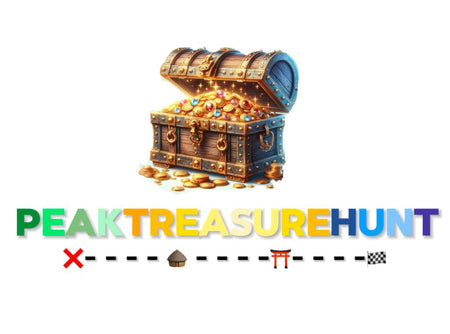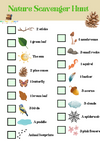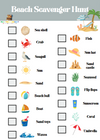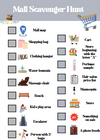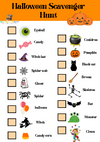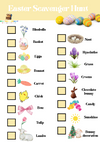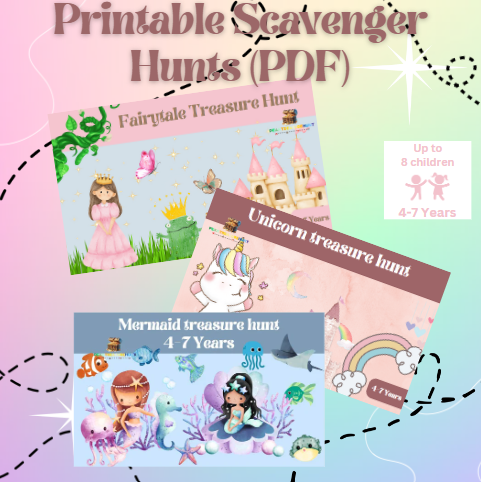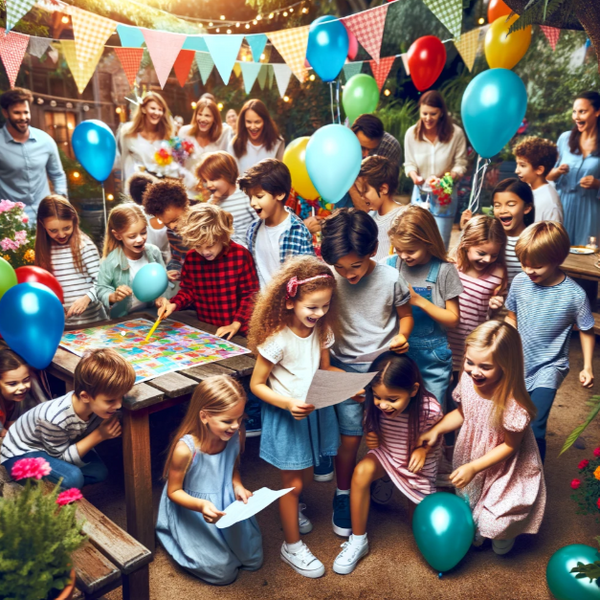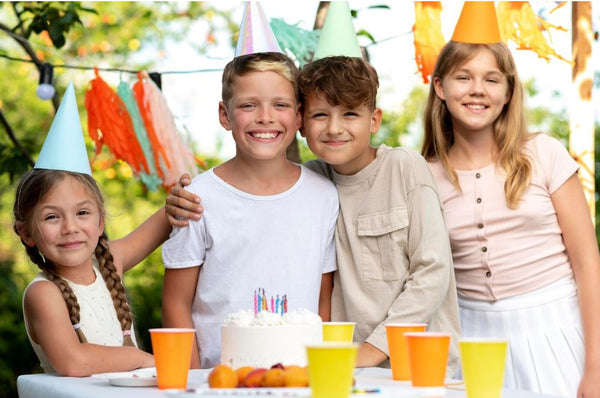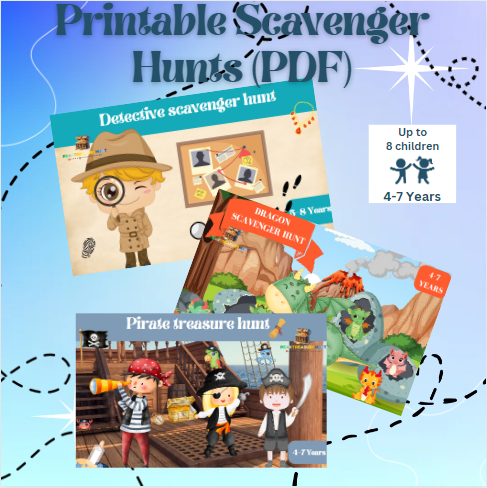
Treasure Hunt-Scavenger Hunt

Discover an innovative concept for printing snip hunt ready games where the children are the real heroes of the story! These great adventure games are ideal for organizing a birthday party or keeping the kids busy during the vacations or other festive occasions!
For a birthday or any other occasion, there's nothing better than a great activity for the kids! Here you will find treasure hunts to print out to take your children on great adventures! Kids love it! Whether they are 4, 5, 6, 7, 8, 9 or 10 years old, they always have a great time. Scavenger hunts, escape games, treasure hunts, you've come to the right place! are you ready?
Scavenger hunt kids
A scavenger hunt is a game in which children and adults have to run through a certain area and solve tasks to find clues that will lead them to the next destination. These tasks can be riddles, puzzles or photography tasks. At the end of the scavenger hunt, the goal is reached, for example a treasure or a reward.
A scavenger hunt is a game in which participants have to find clues and solve tasks in order to get from the starting point to the destination. This can be a series of locations that need to be visited or a series of puzzles that need to be solved in order to get the next clue. Scavenger hunts can take place indoors or outdoors and can be used for a variety of purposes, such as a team-building activity, a leisure activity or a promotional tool.
A scavenger hunt is a type of game or activity where participants must search for and collect a specific list of items or complete a series of tasks or challenges. These items or tasks are usually clues that lead players to the next location or challenge, and the goal is usually to be the first team or person to find all the items or complete all the tasks and reach the final destination. Scavenger hunts can take place indoors or outdoors and can be tailored to different age groups, ability levels and interests. They are often used as team-building activities, party games or educational tools.
Scavenger hunts are dynamic, interactive games that combine the thrill of exploration with the challenge of solving puzzles and uncovering hidden treasures. Perfect for all ages, these hunts are not only a source of entertainment but also a means of education and team-building. Here's what people usually look for when considering a scavenger hunt:
Key Elements:
- Clues and Challenges: The heart of any scavenger hunt, clues can range from simple riddles to complex puzzles, leading participants to the next location or revealing hidden items.
- Theme: A compelling theme, such as pirate treasure, nature exploration, or mystery solving, adds an extra layer of excitement and immersion.
- Location: Scavenger hunts can be organized in various settings, including indoors, outdoors, in a neighborhood, a park, or even across a city.
- Treasure/Prize: The hunt typically culminates in finding a 'treasure' or prize, which can be anything from a physical object to a symbolic reward like a certificate.
Planning Considerations:
- Age Appropriateness: Tailoring the difficulty level of clues and activities to the age group of participants is crucial for ensuring engagement and enjoyment.
- Group Size: Hunts can be designed for individuals, small teams, or larger groups, making them versatile for events like birthday parties, corporate team-building, or family gatherings.
- Safety and Accessibility: Ensuring the safety and accessibility of all participants is paramount, especially for events involving children or in public spaces.
Benefits:
- Educational Value: Scavenger hunts can be educational, teaching problem-solving, navigation, and teamwork skills.
- Physical Activity: They often involve physical activity, which is a fun way to encourage exercise and outdoor exploration.
- Social Interaction: Hunts promote social interaction and collaboration, making them ideal for breaking the ice in new groups or strengthening existing bonds.
Popular Variations:
- Digital Scavenger Hunts: Incorporating technology, these hunts use apps or digital devices to provide clues and challenges.
- Themed Hunts: Tailored around specific themes like Halloween, Christmas, or Easter, these hunts add a festive element to the traditional format.
- Educational Hunts: Designed for schools or educational settings, these focus on learning elements, like historical facts, nature education, or literary themes.
Scavenger hunts are a versatile, enjoyable way to bring people together for an adventure that's as intellectually stimulating as it is entertaining. Whether it's for a special occasion, educational purpose, or just a fun day out, scavenger hunts offer an exciting experience that participants will remember for years to come.
Scavenger Hunt 4-5 YEARS

BIRTHDAY SCAVENGER HUNT AND GAME IDEAS TO PRINT OUT
Print out a treasure hunt, scavenger hunt or police investigation to easily organize your child's birthday at home. Peaktreasurehunt.com is the reference site for downloading and organizing treasure hunts and murder mysteries on all children's favourite themes: pirates, princesses, wizards, soccer, dinosaurs, horses, Halloween, knights, mermaids... Our stories are real fantasy games in which the children are the heroes. They are also very easy for parents to implement. You can also find free scavenger hunts to print out. Fill up on ideas for birthday games at Peaktreasurehunt.com to make your child's party a success!
A scavenger hunt is a great game for children and adults that can be played both indoors and outdoors. Here are some instructions, tips, tricks and ideas to help you run a successful scavenger hunt:
Plan your scavenger hunt in advance: set the start and finish points, create a list of tasks and clues and prepare all the necessary materials.
Choose tasks and clues that are suitable for the age group and abilities of the participants: Tasks and clues should not be too difficult or too easy to challenge and entertain the participants.
Hide the clues and tasks in logical places: Make sure that the clues and tasks are hidden in places that are easily accessible to the participants but still present a challenge.
Give participants a time limit: A time limit helps to maintain tension and ensure that all participants reach the goal within a certain time frame.
Reward the winners: Reward participants who reach the finish line first with small prizes or recognition to encourage them to participate in future scavenger hunts.
Use riddles that fit the theme: If you have a specific theme, it makes sense for the puzzles to match it as well.
Use QR codes or augmented reality: QR codes or augmented reality can help to make the scavenger hunt more interactive and interesting.
Make it social: Allow participants to take photos or videos of themselves on the scavenger hunt and share them on social media to promote the event and get more people to participate in future scavenger hunts.

SCAVENGER HUNT KIDS
1 Click
With just a few clicks, choose a game from our numerous themes such as scavenger hunts or murder mysteries.
2 Print out
Browse the game rules, print the pdf documents and then hide the puzzles where the birthday takes place.
3 Play
Play from the opening story and then guide the children to the treasure or the discovery of the culprit.
A treasure hunt or scavenger hunt can offer many benefits, some of which are:
Encourage teamwork: a treasure hunt or scavenger hunt requires participants to work together to solve tasks and find clues. This can promote communication and trust within a group.
Improve cognitive skills: A treasure hunt or scavenger hunt requires participants to think logically, solve problems and apply spatial orientation skills.
Increase physical activity: A treasure hunt or scavenger hunt that takes place outdoors requires participants to move and thereby increase their physical activity.
Increase motivation: A treasure hunt or scavenger hunt can motivate participants to successfully complete their tasks and reach the goal by rewarding them with small rewards or recognition.
Increase social interaction: A treasure hunt or scavenger hunt allows participants to meet and work with new people, increasing their social interaction.
Increase creativity: A treasure hunt or scavenger hunt sometimes requires participants to think creatively to solve tasks and puzzles, which enhances their creativity.
Entertainment and fun: Treasure hunts or scavenger hunts are an entertaining and fun game for all ages that can be played both indoors and outdoors.
These specially designed treasure hunts are designed to take young explorers on a fun and educational journey.
Our scavenger hunts for preschoolers offer a wealth of activities and puzzles designed to develop their cognitive skills and spark their curiosity. Each scavenger hunt is lovingly designed and includes child-friendly clues, simple riddles and exciting challenges tailored to children's ages and abilities.
As they follow the clues and collect clues, children develop their logical thinking skills, problem-solving skills and spatial orientation. At the same time, their fine motor and sensory skills are encouraged as they are actively involved in the treasure hunt.
Our treasure hunts for 6-7 year olds not only offer a lot of fun, but also a number of educational benefits. Children learn to work together as a team, improve their communication skills and understand the importance of sharing and cooperation.
Each scavenger hunt is themed and offers children the opportunity to immerse themselves in an imaginative world. Whether they feel like pirates on a treasure hunt, brave explorers on a jungle adventure or princesses in an enchanted castle, the scavenger hunts will stimulate their imagination and spark their imaginations.
Our scavenger hunts for children aged 6-7 are designed to be played both indoors and outdoors. You can easily do them at home, in the garden or even in a nearby park.
So get ready to offer your little adventurers an unforgettable experience. Discover with them the joy of solving puzzles, the excitement of the treasure hunt and the happiness of success. Our scavenger hunts for 6-7 year olds will delight them and give them an unforgettable time of fun and discovery.
Scavenger hunts for 6-7 year old children offer a unique blend of adventure, learning, and playful exploration, making them a popular choice for parents and educators. Tailored to the developmental stage of this age group, these hunts are designed to captivate their imagination and encourage a range of skills. Here's what you need to consider when organizing a scavenger hunt for this age range:
Key Elements:
- Age-Appropriate Clues: For 6-7 year olds, clues should be simple, clear, and engaging. Picture clues, basic riddles, and rhymes work well. Avoid overly complex language or puzzles that might lead to frustration.
- Safe and Familiar Locations: Ideal locations include places where children feel safe and comfortable, like backyards, local parks, or within a school. Indoors, homes and classrooms offer great environments.
- Interactive and Educational Themes: Popular themes like nature, pirates, animals, or favorite storybook characters can make the scavenger hunt more relatable and enjoyable.
Planning Considerations:
- Short and Sweet: Keep the duration manageable – around 30 minutes to an hour – to align with the attention span of this age group.
- Supervision: Ensure adequate adult supervision throughout the hunt for safety and guidance.
- Group Dynamics: Consider organizing the children into small teams to encourage teamwork and social interaction, or have them participate individually for a more focused experience.
Benefits:
- Educational Value: Scavenger hunts at this age can help develop observational skills, basic problem-solving, and early reading abilities.
- Physical Activity: These hunts encourage active play, which is crucial for physical development and health.
- Creativity and Exploration: Engaging with the environment through a themed scavenger hunt fosters creativity and curiosity.
Typical Inclusions:
- Nature Hunts: Focused on exploring and identifying elements in nature, such as leaves, bugs, or simple outdoor features.
- Story-based Hunts: Using a simple narrative or storybook characters to frame the hunt, making it an immersive experience.
- Color and Shape Hunts: Ideal for this age, focusing on finding objects of specific colors or shapes.
Safety and Accessibility:
- Secure Environment: Ensure the scavenger hunt area is free from potential hazards and is accessible for all children participating.
- Clear Boundaries: Establish clear physical boundaries where the children can search.
Rewards and Recognition:
- Simple Prizes: Small tokens like stickers, certificates, or a healthy treat can be given as rewards.
- Praise and Encouragement: Positive reinforcement is important for this age group, so ensure each child is praised for their participation and discoveries.
Wrap-up Activity:
- Debrief Session: Post-hunt, a short discussion or storytelling session can help children process their experience and share their discoveries.
Organizing a scavenger hunt for 6-7 year olds is a rewarding experience that can provide children with a memorable adventure full of learning and fun. By focusing on age-appropriate challenges and ensuring a safe and engaging environment, these scavenger hunts can be an exciting and beneficial activity for young children.
Scavenger Hunt 6-7 YEARS
These adventures are designed to challenge young explorers, expand their skills and create unforgettable experiences.
Our scavenger hunts for 8+ year olds offer a mix of fun, excitement and education. Each scavenger hunt is carefully designed and contains challenging riddles, tricky tasks and interesting background stories to spark children's imaginations.
As they follow the clues and overcome various challenges, children are encouraged to use their cognitive skills such as logical thinking, problem-solving skills and spatial awareness. They develop strategic planning skills, improve their observation skills and learn to make connections.
Our scavenger hunts for 8+ year olds not only promote their mental development, but also offer a lot of fun and adventure. The children become active participants as they explore different locations, solve puzzles and complete mysterious tasks. This boosts their self-confidence, teamwork skills and ability to act under pressure.
In addition, our scavenger hunts for 8+ year olds emphasize the promotion of social skills. The children learn to work together as a team, improve their communication skills and understand the importance of listening and treating each other with respect.
Each scavenger hunt is themed and offers the children the opportunity to immerse themselves in exciting worlds. Whether they are brave adventurers exploring a treasure island, detectives solving a mysterious case or explorers searching for hidden secrets in nature, our scavenger hunts provide a captivating backdrop for their journeys of discovery.
Our scavenger hunts for 8+ year olds can be played both indoors and outdoors. You can do them at home, in the school playground or in a nearby park. Outdoor play allows children to get exercise, get some fresh air and actively explore their surroundings.
Prepare to offer your little adventurers an unforgettable time. Discover with them the joy of solving puzzles, the excitement of the search and the happiness of success. Our scavenger hunts for 8+ year olds will awaken their curiosity, strengthen their skills and offer them unforgettable experiences.
Scavenger hunts for eight-year-old children are specially designed adventures that combine fun, learning, and physical activity. These hunts are perfect for birthday parties, school events, or just a day of outdoor exploration. Here’s what you need to know when planning a scavenger hunt for this age group:
Key Features:
- Age-Appropriate Clues: The clues should be challenging yet achievable for eight-year-olds. They can include simple riddles, puzzles, map reading, and picture-based clues. The language used should be easy for children of this age to understand.
- Engaging Themes: Popular themes that resonate with eight-year-olds can include pirates, animals, superheroes, space exploration, and nature. A good theme can significantly enhance the excitement and engagement of the children.
- Safe Locations: Choose locations that are safe and appropriate for children. Options include backyards, local parks, playgrounds, or a safe section of a neighborhood. Indoor options can include homes, classrooms, or community centers.
Planning Aspects:
- Group Size and Teams: Scavenger hunts for eight-year-olds work well both individually and in small teams. Teams encourage collaboration and social skills.
- Duration and Complexity: The hunt should be long enough to be engaging but not so long that it becomes tiring. Approximately 30 minutes to 1 hour is usually sufficient.
- Safety Measures: Safety is paramount. Ensure the hunt area is secure and that children are supervised. Set clear boundaries where the children can and cannot go.
Benefits:
- Educational Value: These scavenger hunts can be educational, teaching children problem-solving skills, basic navigation, and teamwork.
- Physical Activity: The hunts encourage physical movement, which is vital for children’s health and well-being.
- Creativity and Imagination: Participating in themed scavenger hunts stimulates creativity and imagination among children.
Popular Variations:
- Nature Hunts: These involve finding and identifying different types of plants, insects, or birds, encouraging an appreciation for nature.
- Treasure Hunts: Involving a storyline about searching for hidden treasure, often concluding with a small prize or treat.
- Mystery Hunts: These involve solving a mystery, which can be an engaging and thought-provoking activity.
Incorporating Technology:
- Digital Elements: For a modern twist, incorporate digital elements like using a smartphone for GPS-based clues or taking photos as proof of finding an item.
Prizes and Rewards:
- Completion Rewards: Small rewards or prizes at the end of the hunt can be a great motivator. These can be simple items like stickers, toys, or certificates.
Post-Hunt Activities:
- Debriefing Session: After the hunt, have a group discussion about what they found challenging or enjoyable. This can help in developing their reflective thinking.
Scavenger hunts for eight-year-olds are a fantastic way to celebrate special occasions or simply to provide an entertaining and constructive activity. They offer an ideal balance of fun, learning, and physical activity, making them a favorite among children and parents alike.
Scavenger Hunt 8+ YEARS
Scavenger Hunts Free is a concept that brings the excitement and challenge of scavenger hunts to everyone without any cost. This approach to scavenger hunts democratizes a traditionally fun and educational activity, making it more accessible to a broader audience. The idea is to create scavenger hunts that require no entry fees, making them perfect for community events, educational purposes, or just as a fun, cost-free activity for groups of friends or families.
Key Aspects of Scavenger Hunts Free:
- Cost-Free Participation: The primary appeal of Scavenger Hunts Free is the removal of any financial barriers to participation. This inclusivity allows individuals from all backgrounds to engage in this fun and enriching activity.
- Community Engagement: These scavenger hunts often foster community spirit. They can be organized by local groups, schools, or community centers, encouraging participants to explore their surroundings, learn about local history, or engage with their community in new ways.
- Educational Opportunities: Scavenger Hunts Free can be designed with educational themes, such as local history, nature, or sustainability. This makes them a fantastic tool for learning in an interactive and enjoyable manner.
- Creative and Resourceful Challenges: Without the lure of expensive prizes or high-tech gadgets, these hunts often rely on creativity and resourcefulness. Challenges may include finding specific items in nature, solving riddles related to local landmarks, or completing tasks that encourage teamwork and problem-solving.
- Accessibility for All Ages: These activities can be tailored to suit various age groups, ensuring that everyone from children to adults can participate and enjoy the experience.
- Use of Technology: Even without a budget, technology can play a role. Organizers can use social media, free apps, or websites to distribute clues, track progress, or share information about the hunt.
- Environmental Awareness: Scavenger Hunts Free can be an excellent way to promote environmental education and stewardship, encouraging participants to engage with and learn about their natural surroundings in a respectful and sustainable manner.
Scavenger Hunts Free is not just an activity; it's a community experience that brings people together for fun, learning, and adventure. It proves that enjoyable and educational experiences don't have to come with a price tag, making the joy of discovery and the thrill of the hunt available to everyone.
Scavenger hunts are a fantastic way to engage in fun, exploration, and learning without breaking the bank. Free scavenger hunts offer the same level of excitement and challenge as their paid counterparts, making them an attractive option for a wide range of events. Here's what you need to know when planning a free scavenger hunt:
Essential Components:
- Clues and Riddles: Central to the scavenger hunt, the clues can be crafted creatively at home. They can range from simple riddles to more complex puzzles, leading participants to their next destination or task.
- Themes: Choose a theme that resonates with your group. Popular themes include nature exploration, neighborhood discovery, historical trails, or literary adventures, all of which can be designed without a cost.
- Locations: Utilize free public spaces like local parks, community centers, or your neighborhood. Even a home or backyard can be transformed into an exciting scavenger hunt venue.
- Prizes: The hunt can culminate in finding a symbolic prize, such as a homemade certificate, a crafted trophy, or a special privilege (like choosing the next family movie or game).
Planning Aspects:
- Age and Group Size: Tailor the scavenger hunt to fit the age and size of your group. Smaller, family-oriented hunts can be more intimate, while larger group hunts offer a broader, more socially interactive experience.
- Safety and Accessibility: Safety is paramount, especially in public spaces. Ensure that the hunt is accessible to all participants and that the locations are safe for the age group involved.
- DIY Approach: Embrace the DIY spirit by creating your own clues, decorations, and even using smartphone cameras for digital clues or evidence of tasks completed.
Benefits:
- Educational and Fun: Scavenger hunts are not only enjoyable but also educational. They can teach problem-solving, navigation, historical knowledge, and nature appreciation.
- Encourages Physical Activity: These hunts often involve walking or mild physical activity, making them a fun way to encourage movement and exploration.
- Social Interaction and Teamwork: Participants learn to work together and communicate effectively, enhancing social and teamwork skills.
Popular Variations:
- Digital Hunts: Use smartphones or digital devices to create a modern scavenger hunt. Participants can receive clues via text or email, take pictures as proof of task completion, or use GPS for location-based clues.
- Nature Scavenger Hunts: Focus on the natural environment, where participants look for specific types of plants, animals, or natural formations.
- Community-Based Hunts: These involve local landmarks, historical sites, or community-specific themes, encouraging participants to learn more about their surroundings.
Free scavenger hunts are an excellent way to organize an engaging, memorable activity without the need for expensive resources. With creativity and planning, you can craft an experience that is both enjoyable and enriching, perfect for family outings, educational activities, team building, or simply a fun day out with friends.
Treasure Hunt - Scavenger Hunt Free
A scavenger hunt is an exciting and fun activity for children and adults alike. It can take place outdoors or indoors and requires a little planning in advance. If you are planning a scavenger hunt and are looking for a quick and easy way to create the tasks for the participants, then scavenger hunt printables in PDF format are a great option.
A scavenger hunt printable PDF is a collection of riddles, clues, codes and other challenges that need to be solved by the participants in order to reach the goal of the scavenger hunt. These tasks are summarized on a PDF document and can be easily printed out to give to the participants. They can also be placed using the instructions on the PDF document to organize the scavenger hunt.
A great advantage of scavenger hunt tasks to print PDF is that they are easy to customize and personalize. You can create your own tasks to suit the interests and ages of the participants. In addition, they are easy to print and distribute, making the planning and execution of the scavenger hunt very simple.
Overall, scavenger hunt tasks to print PDF offer a quick, easy and cost-effective way to organize a scavenger hunt and ensure that participants have a great time. So if you are planning a scavenger hunt and are looking for quick and easy solutions, then scavenger hunt tasks to print PDF are definitely worth a try.
Easily organize a scavenger hunt for kids to organize a birthday party! Also discover our murder mysteries and escape games for children from 4 to 12 years old.
Our website is dedicated to families who want to organize a fun and educational activity using an original concept of "ready to use" game sets to print.
There are many different scavenger hunt sets for children that you can find online and print out. These sets usually contain a list of tasks and clues that the children have to solve in order to reach their destination. They often also include cards, riddles and other materials needed to play.
There are also other birthday games that you can print out, such as:
-word puzzles
-quizzes
-coloring pages
-Labyrinths
-memo games
-crossword puzzles
-treasure hunt
-etc..
It is a good idea to make sure that the game matches the children's interests and abilities before printing it out and that all the materials needed are easily accessible.
A treasure hunt is a popular game for children's birthday parties and provides lots of fun and excitement. In this article, we have collected ten ideas for the perfect treasure hunt that are suitable for children of all ages. We'll give you tips on how to prepare and design tasks to make the treasure hunt a complete success. You should pay attention to a few things when organizing the hunt so that the children don't get frustrated and instead have a nice surprise waiting for them at the end.
A scavenger hunt can also be perfectly incorporated into the theme of a theme party. You can formulate a short story to get the children in the mood for the hunt. A scavenger hunt is possible both indoors and outdoors, depending on the setting. To help you prepare, we have created a step-by-step guide for you.
Of course, a treasure map is an essential part of any treasure hunt. Depending on your drawing skills, you can design the map yourself or use a template from the Internet. The treasure is the highlight of the hunt and can consist of a piñata or a treasure chest. It is important that the children receive a fair and equitable distribution of sweets.
The tasks should be designed in such a way that they are not too difficult or too easy for the children. Cooperative games in which the children work as a team are particularly popular. We have listed ten of our favorite stations for you to use as inspiration.
1. Treasure hunt: The children have to solve clues and riddles to find the treasure. The treasure can contain a treasure chest with sweets or small gifts.
2. Animal hunt: The children have to find different animals on a list and take photos of them, you can also hide small animal figures in the garden or in the home for the children to find.
3. Color hunt: The children have to find and collect different objects in certain colors. For example, they could look for red, blue or green things.
4. Ghost hunt:The children have to look for hidden ghosts and mark them with a pen or sticker.
5. Puzzle hunt:The children have to find different puzzle pieces and put them together to get a picture or a clue.
6. Letter hunt:The children have to find and collect different letters to form a word or sentence.
7. Nature hunt: The children have to collect various natural objects such as leaves, stones or flowers.
8. Shape hunt: The children have to find and collect different shapes such as circles, triangles or squares.
9. Code hunt: The children have to crack various codes to find the next clue or the destination.
10. Music hunt: The children have to find and identify different musical instruments or sounds in the garden or at home.

SCAVENGER HUNT, INVESTIGATIONS & ESCAPE GAME FOR YOUNG AND OLD
Our treasure hunt, detective and escape game sets for children are organized by age group and have been designed by a specialist for young children, a state-certified early childhood educator. We pay great attention to the design of our birthday games in order to meet and fulfill the expectations of both children and parents. With our printable treasure hunt kits for children, you can learn through play and easily organize a game together for a birthday party or family activity.
Scavenger hunts, investigations and escape games are popular activities for people of all ages.
A scavenger hunt is a game in which participants have to find clues and solve tasks to get from the starting point to the destination. The tasks can be riddles, puzzles or photography tasks and the scavenger hunt can take place indoors or outdoors.
An investigation game is a type of game in which participants take on the role of detectives or investigators and have to solve a case by collecting clues and analyzing evidence.
An escape game is a type of interactive adventure game in which participants are locked in a room and have to solve puzzles to escape within a set time.
All of these games are best played in groups, and they provide a great way to encourage teamwork and communication. They are also a great way to sharpen mental skills and enjoy time with friends and family.

COMPLETE GAMES FOR A SUCCESSFUL ANIMATION!
This makes organizing a birthday party child's play!
The treasure hunt concept for children that works everywhere and for everyone!
With "peaktreasurehunt", the specialist in treasure hunts for children aged 4 to 12, the headache of organizing a birthday party is a thing of the past!
There are many different types of complete games that can be used for a successful animation. Some examples are:
Scavenger hunts: A game in which participants have to search for clues and solve tasks in order to get from the starting point to the destination.
Investigation games: A type of game in which participants take on the role of detectives or investigators and must solve a case by collecting clues and analyzing evidence.
Escape games: A type of interactive adventure game in which the participants are locked in a room and have to solve puzzles within a certain time in order to escape.
Quiz or guessing games: Games where participants have to answer questions or solve puzzles to earn points.
Team tasks: Games in which participants have to work in groups to complete tasks, e.g. assembling a puzzle, completing an obstacle course, etc.
Sports games: Games such as tug of war, sack races, volleyball, etc.
An important aspect of successful animation is choosing the right game for the target group. It is important to choose games that match the interests and abilities of the participants and that are suitable for the event (e.g. outdoor or indoor games). Thorough preparation and organization are also important to ensure that the game runs smoothly and that all participants have a good time.

INSTRUCTIONS, TIPS, TRICKS & IDEAS
Doing a scavenger hunt yourself? Great idea!
Over the years, numerous articles have been created to answer all your (!) questions. From "How do I organize a scavenger hunt?" to "What's in the treasure chest?" I work on scavenger hunts&treasure hunts and all parts of the scavenger hunt. Because whether it's a children's rally, a scavenger hunt or a scavenger hunt for adults - the basic structure is the same.
If you are new to the search for information, be sure to start with the excellent scavenger hunt guide. If you have specific questions about scavenger hunts and treasure hunts, please enter a search term in the search box (e.g. below). I bet you'll find out!
Whether you're planning a treasure hunt or scavenger hunt for a children's birthday party, a team building event or just for fun, this activity offers a variety of benefits for everyone involved. It's an exciting way to have fun, develop skills and create shared memories. So, why not try a treasure hunt or scavenger hunt and embark on an adventure full of fun and discovery? Immerse yourself in the world of treasure hunts and scavenger hunts and experience unforgettable moments full of fun, challenges and teamwork.
Whether you're a parent planning a special activity for your children, a teacher looking to liven up the classroom, or just someone looking for an exciting adventure, a treasure hunt or scavenger hunt offers something for everyone.
You will find that a treasure hunt or scavenger hunt is not just a game, but also enriches the participants in many ways. It promotes the development of cognitive skills such as logical thinking, problem solving and spatial orientation. At the same time, it strengthens teamwork, communication and trust within a group.
A treasure hunt or scavenger hunt gives you the opportunity to spend time outdoors with other people and engage in physical activity. It's a wonderful opportunity to explore nature, get some fresh air and discover new places.
Last but not least, a treasure hunt or scavenger hunt provides entertainment and fun for all participants. It creates an exciting atmosphere full of secrets and surprises. Whether you take part alone, with friends or as a family, a treasure hunt or scavenger hunt promises unforgettable moments and lots of laughter.
So, what are you waiting for? Immerse yourself in the fascinating world of treasure hunts and scavenger hunts. Discover new challenges, experience adventures and create memories together. Plan your next treasure hunt or scavenger hunt and let the fun begin!

WHY SHOULD YOU DO A TREASURE HUNT/SCAVENGER HUNT?
Treasure hunt, scavenger hunt, investigation, rally, hidden object game... whatever you call it, all these games with riddles and clues are quite simply one of the best ways for young and old to have fun, work together and have a great time. The joy of discovery is universal. Going on a treasure hunt, solving a puzzle and shedding light on the unknown is a basic energy for everyone.
We love to solve a puzzle, a riddle or a mystery, we feel euphoric when the solution clicks in our head like a key in a lock. A treasure hunt satisfies this need to solve a mystery. The scavenger hunts on this website challenge players or teams to solve a mystery or a series of puzzles or problems.
Not only is a treasure hunt or scavenger hunt a fun game, but it also offers a variety of benefits and reasons why you should consider such an activity. Here are some reasons why a treasure hunt or scavenger hunt is a great choice for people of all ages:
1. Fun and entertainment: A treasure hunt or scavenger hunt provides fun and entertainment. It is an adventure that fills the participants with excitement and joy as they search for clues and set off in search of the hidden treasure.
2. Encouraging teamwork: A treasure hunt or scavenger hunt often requires teamwork. By working together in groups, participants learn to communicate effectively, collaborate and use their problem-solving skills.
3. Promoting cognitive skills: A treasure hunt or scavenger hunt stimulates logical thinking, cognitive flexibility and problem-solving skills. Participants have to interpret clues, solve puzzles and complete various tasks to reach their destination.
4. Physical activity: A treasure hunt or scavenger hunt that takes place outdoors promotes physical activity. Participants have to move, run and sometimes even overcome obstacles to find the clues and reach the treasure.
5. Promotes social skills: A treasure hunt or scavenger hunt provides an opportunity to meet and work with new people. This encourages social interaction, sharing ideas and building friendships.
6. Encouraging creativity: A treasure hunt or scavenger hunt often requires creative thinking to solve puzzles and find unexpected solutions. Participants are encouraged to think outside the box and use their imagination.
7. Reward and sense of achievement: A treasure hunt or scavenger hunt offers participants the opportunity to celebrate success and feel rewarded. The feeling of finding the treasure or reaching the goal gives a sense of fulfillment and satisfaction.
FAQ
The term "scavenger hunt" originates from the idea of scavenging or searching for items. In a scavenger hunt, participants are tasked with gathering a list of specific items or completing certain tasks, often requiring them to explore and discover these items in different locations. The term captures the essence of searching and collecting, akin to how scavengers in nature search for and collect food or resources. The activity combines elements of exploration, problem-solving, and adventure.
During a scavenger hunt, participants have to solve various tasks and puzzles in order to find their way to the destination. The tasks can be varied, such as solving brain teasers, finding hidden objects, collecting clues at various stations or mastering skill tasks. The tasks are often themed and fit in with the theme of the scavenger hunt.
A successful scavenger hunt requires good preparation and planning. First, an interesting theme or motto should be selected that appeals to the participants. Then design clues and tasks that are appropriate for the age and interests of the participants. It is important to adjust the level of difficulty of the tasks so that the children have fun and are not overwhelmed. The route of the scavenger hunt should be carefully planned to ensure that it runs smoothly. Safety aspects should also be taken into account, especially if the scavenger hunt takes place outdoors. A clear start and finish instruction as well as a reward for successful participation round off the scavenger hunt.
There are lots of cool activities to do for a birthday. Some ideas could be: a themed party with suitable costumes, an outdoor treasure hunt or scavenger hunt, a visit to an amusement park, a creative workshop such as painting or crafting, a trip to the zoo or animal park, an overnight party with friends, a baking or cooking event, a movie screening with favorite films, or a sporting event such as bowling or mini golf. The choice of activity should match the age and interests of the birthday child.
Celebrating a child's birthday at home offers many opportunities for a fun and intimate celebration. You could plan games and activities in the garden or living room, such as potting, treasure hunts, crafts, painting, singing or dancing. A sleepover party with a movie night and pyjama party can also be a lot of fun. The decorations and food could be designed according to the birthday theme. It is important that the party is age-appropriate and safe so that the little guests feel comfortable and happy.
There are a variety of activities at a children's birthday party that can entertain and excite the little guests. In addition to classic games such as pot-knocking, sack races or egg races, you could organize a treasure hunt or scavenger hunt where the children follow clues and riddles to find hidden treasures. Creative activities such as painting, arts and crafts or baking allow children to discover their artistic side. Entertaining outdoor games such as ball games, hide and seek or jumping rope provide exercise and fun. It is important to adapt the activities to the age of the children so that everyone feels comfortable and has a great time.
You can celebrate your child's birthday at different locations, depending on the birthday child's preferences and your possibilities. At home is a popular option, as it is a familiar environment and you can organize the party as you wish. If you have enough space in the garden, you could also hold the party outdoors and organize games in the garden. Indoor play parks or children's centers offer a variety of play options and attractions that will delight the children. Alternatively, you could also plan a trip to a theme park, zoo, animal park or adventure park to make the birthday a special experience.
A children's birthday party should not be without a few important elements to create an unforgettable celebration. These include:
Birthday cake: A delicious and beautifully decorated birthday cake with lighted candles so that the birthday child can make their wish as they blow out the candles.
Games and activities: Fun games, activities and maybe even a treasure hunt or scavenger hunt to keep the children entertained and busy.
Gifts: Small gifts for the guests to thank them for attending the party.
Decorations: Festive decorations that give the party location a cheerful atmosphere and match the theme of the birthday.
Catering: Delicious food and drinks that the little guests will enjoy and give them enough energy for the activities.
Music and dance: Music that encourages dancing and partying and lightens the mood.
A child's birthday is usually celebrated on the child's birthday, i.e. the day the child was born. However, in some cultures it may be customary to celebrate the birthday on a different day that is closer to a weekend or when family and friends have more time to attend the celebration. The celebration can take place at home or at another venue such as an indoor play park, children's center or outdoor playground. The time can vary depending on the age of the children and the activities, but children's birthday parties are usually held in the afternoon so that the little guests are well-rested and fit.
A children's birthday party in winter offers numerous opportunities for unique and unforgettable celebrations. Despite the chilly temperatures, with a little creativity and planning you can create a warming and cheerful party.
1. Winter outdoor activities: Take advantage of the beauty of the winter landscape to organize activities such as sledding, snowman building or a snowball fight. A treasure hunt in the snow can also be an exciting adventure for the children.
2. Indoor party games: If the weather is too cold, various indoor games are a great option. Popular classics such as pot-kicking, hide-and-seek or themed games and puzzles can be adapted to the winter theme.
3. Craft activities: Crafting winter decorations, such as paper snowflakes, colorful lanterns or small gifts, can delight children of all ages. These activities encourage creativity and give children the opportunity to take something handmade home with them.
4. Winter film afternoon: Organize a cosy film screening with winter or Christmas films. Prepare warm drinks such as cocoa or tea and tasty snacks.
5. Baking and cooking: Baking or cooking together is not only a fun activity, but also an educational one. Baking cookies, decorating gingerbread or preparing simple, child-friendly recipes can be part of the celebration.
6. Themed decorations: Create a winter atmosphere with appropriate decorations such as icicles, snowflakes and twinkling lights. Themed table decorations and party accessories can further enhance the mood.
The combination of these elements can turn a children's birthday party in winter into a warm and cheerful experience that will give the children lots of fun and enjoyment despite the cold outside.
Treasure Hunt Blog
Children's Birthday Party Planner
🎈🥳Children's Birthday Party Planner: A Comprehensive Guide to Creating Memorable Celebrations Planning a children's birthday party can be a daunting task, but with the right guidance and...
Children's Birthday Party Invitations
🥳😍Crafting Perfect Children's Birthday Party Invitations When it comes to planning a children's birthday party, one of the most important aspects is crafting the perfect invitations....
Children's Birthday Party Venues Near Me
🎁🎈Ultimate Guide to Children's Birthday Party Venues Near Me Finding the Perfect Children's Birthday Party Venue: A Comprehensive Guide Planning your child's birthday party can be both...
Birthday Scavenger Hunt for Kids
🎁🎈🎉The Ultimate Birthday Surprise: A Scavenger Hunt for Kids Explore, Discover, and Celebrate: Making Birthdays Unforgettable with a Scavenger Hunt Welcome to the exciting world...
Scavenger Hunt Birthday Party
🎈🎁🎉Adventure Awaits: Hosting an Exciting Scavenger Hunt Birthday Party Unveiling the Ultimate Guide for a Thrilling Celebration Welcome to the world of mystery, excitement, and...
Places for Birthday Parties
🎈🎁Ultimate Guide to Hosting Birthday Parties: Top Places for Birthday Celebration Planning a birthday party for your child can be both exciting and daunting. One of...
Tooth Fairy Scavenger Hunt for Kids!
🦷🧚♀️💎Exploring the Magic: Unveiling the Tooth Fairy Scavenger Hunt Adventure A Magical Quest: Dive into the Tooth Fairy Scavenger Hunt Journey Welcome to an enchanting adventure,...
How Much Money Should The Tooth Fairy Give?
🦷🧚♀️Tooth Tales: Exploring the Magic of the Tooth Fairy Welcome to the magical realm of the Tooth Fairy, where childhood wonder meets the excitement of lost...
Printable Birthday Treasure Hunt Clues for Kids!
Looking to take your child's birthday party to the next level of excitement? Look no further! Dive into the world of birthday treasure hunts, where...
